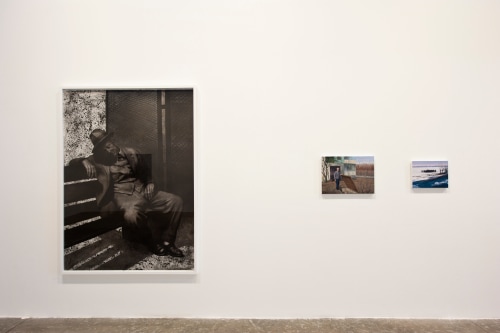
Referencing History, Installation view at Green Art Gallery, Dubai, 2012
Political commentators around the world have been drawing comparisons between the events of the Arab Spring and the Romanian revolution of 1989 that led to the overthrowing and death of dictator Nicolae Ceausescu. With the removal of long entrenched dictatorial regimes in the Arab world, artists in this region are now faced with the challenge of interpreting in their work the turbulence and the changing social and political order around them.
In this context, it is interesting to look at how artists from Eastern Europe have grappled with similar issues. This is the basic premise of Referencing History, an exhibition that showcases the work of well-known Eastern European artists Marius Bercea, Zsolt Bodoni, Ivan Grubanov, Ciprian Muresan, Daniel Pitin, Mircea Suciu, Serban Savu and Alexander Tinei.
Jane Neal, the UK-based curator of the show, has also included artworks by Iranian artists Kamrooz Aram and Ali Banisadr and Turkish artist Hale Tenger to add a regional perspective to the theme. "I have been working with artists from Eastern Europe for many years and I believe that this is a timely moment to develop a dialogue between them and artists from this region. All the artists in this show share an active interest in history, be it a collective or a personal one. Their work challenges long-held belief systems, political structures, or seemingly innocent nostalgia for the past and provokes viewers to think about personal and collective preconceptions and mindsets that remain even after regimes fall," Neal says.
The work of the Eastern European artists reflects their experiences of growing up under dictatorial regimes and witnessing their disintegration. But it goes beyond personal history to question notions of political, social and religious conformity; to understand how various ideologies and systems of control originated; to introspect on the long term impact of social and political indoctrination; and to examine the biased perspectives from which history is often written.
Hungarian artist Bodoni investigates the tools of power under various regimes through the prism of his own childhood experiences. His painting, Educatio, comments cynically on changing icons and heroes through a subtle reference to secret communist era foundries, where old statues were recycled to make sculptures of communist leaders.
Another composition, In Bloom, is based on a famous 18th century painting of May Day celebrations. But he has replaced the smiling people celebrating in open fields from the original painting, with tired looking young girls sitting in orderly rows and surrounded by horses wearing gas masks.
Savu's work is about the long-term impact of a communist era social experiment in Romania called The New Man. Under this programme, countless people were forced to relocate from the countryside to public housing blocks on the peripheries of cities. But the experiment failed because they were unable to adapt to urban life. Savu's paintings depict people who seem detached from their urban surroundings, highlighting the effect of flawed ideology on not one but several generations.
Bercea's colourful landscapes allude to the ‘modern' architecture of his childhood in post-communist Romania. Whereas Suciu's charcoal drawings of ordinary Romanians and figures of authority highlight the danger of trusting people and systems that are fallible. Muresan, also from Romania, uses humour in his video to question rituals or group activities accepted as normal social behaviour.
Czech artist Pitin combines influences from communist era films and textbooks and classic film noir to recreate an atmosphere that evokes old memories. Tinei was born in Moldova during the Soviet era and his work refers to the fact that he grew up in an alien culture and knew nothing about his own culture. His portraits of people, who are marked by their suffering, address issues of identity and belonging. Serbian artist Grubanova explores the idea of creating a memorial based on collective memory to help us understand the past and move forward.
Aram and Banisadr are both Iranians based in the US and their work offers the perspective of exiles who straddle two cultures. Aram's collages from a series titled 7,000 Years of History combine Islamic ornament with modern Western abstraction to examine national, religious and cultural belief systems.
Banisadr blends European art history with the ancient Persian miniature tradition to create apocalyptic paintings that comment on the constant conflict in society and our inability to learn from history.
Tenger's offering in this show is a glass cabinet containing a crystal shoe placed on a velvet cushion. Titled Give Me Back My Innocence, this piece draws on the story of Cinderella to comment on the growing materialism and individualism in our society, and to critique both capitalist and religious doctrines.